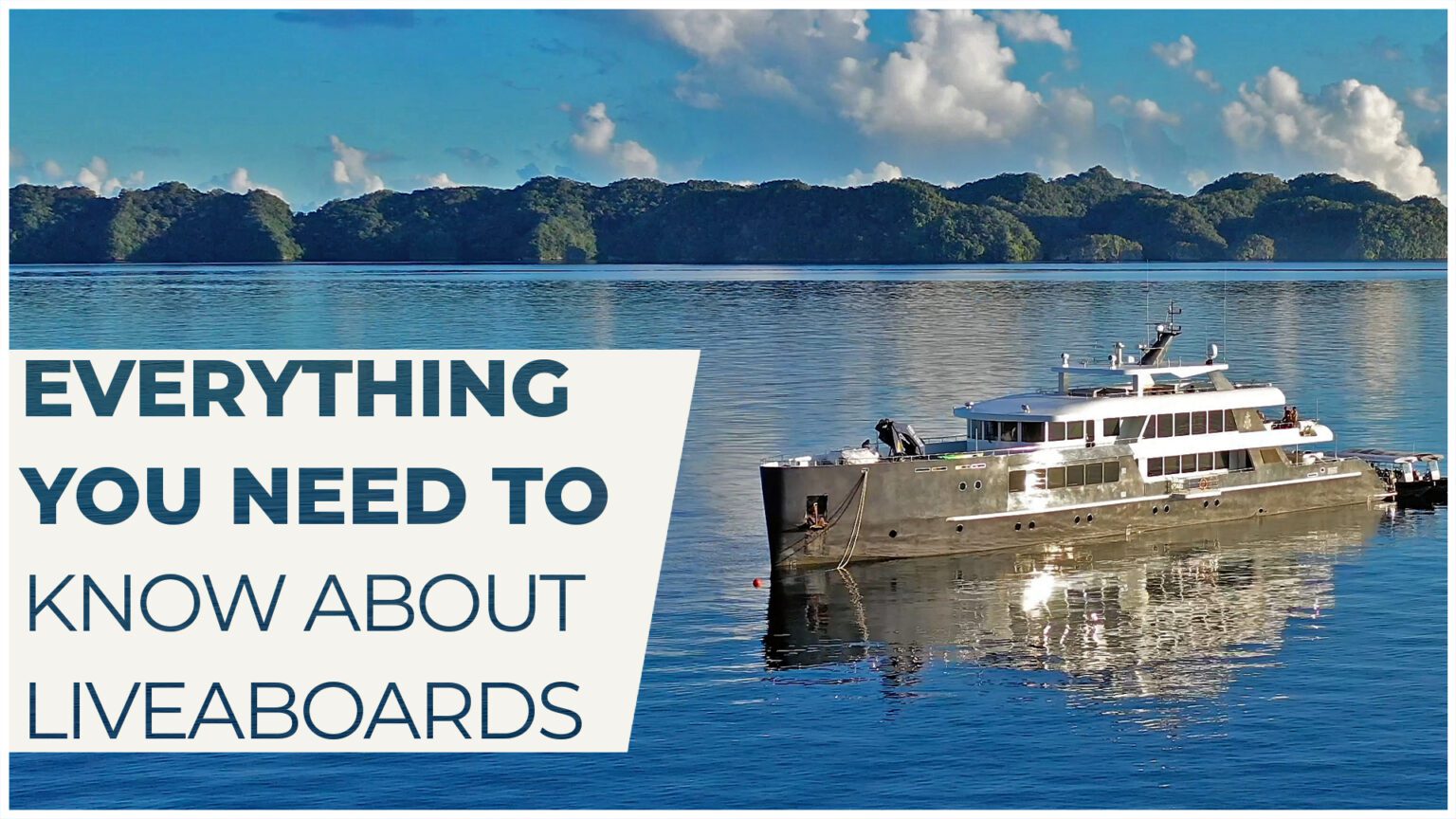This Liveaboard Guide is going to breakdown what to expect on a liveaboard, such as what facilities there are likely to be onboard the vessels. How you should prepare for a liveaboard, what to bring, what you don’t need to bring and some general do’s and don’ts about liveaboard diving.
Liveaboards are the perfect way to really crank up your dive log numbers and build your scuba diving experience because you’re in and out of the water more frequently and surrounded by a lot of other divers talking about scuba diving. Whether you’re travelling as a family group or all by yourself, you’re going to find a new group of friends to go diving with and socialise.

What Are Liveaboards Like?
So, what are you likely to find on or in a liveaboard? A Liveaboard is typically a large motor yacht with multiple cabins, open air resting and sunbathing decks as well as a dedicated dive deck. On some of the fancier vessels you may also find hot tubs, photography studios and more. The exact layout and deck count can vary between vessels but, the fundamentals are usually the same.
From top to bottom, the very top deck is most often the sun deck. This is where a lot of divers work on their tans between dives, because wetsuits don’t give the best tan lines, and the sun deck is usually a great place to get a 360 view of where you are as well as some fresh air, some divers even sleep up here under the stars if the weather is nice enough.
Down a staircase or ladder is a more covered, open-air area at the back of the boat where most divers relax between dives. It’s typically covered to protect you from the sun but, still open to the fresh air. Comfortable seating and tables let you relax and chat with other divers and it’s not unusual to find somebody sleeping here between dives or reading a good book, editing photos on a laptop, listening to music. You can also find some cabins on this deck which are nice as they’re up high away from engine noise.
Down one deck and you find the main deck which is split in two sections. The central inside space is an air-conditioned common space where you have dinner, dive briefings, some vessels have areas with tables for sorting out logbooks and photographs, even TVs for presentations. You can take part in some scuba cert courses onboard if you like and earn another cert card.
Then outside at the back of the boat is the dive deck. Here is where you’ll have your own cylinder on a bench and your cylinder will be topped up where it is between dives so, you don’t need to swap cylinders over or anything. All you need to do is unscrew your regs after the dive so the crew knows to top that cylinder up. You also have a crate under your cylinder for the rest of your dive gear like mask and weights and things to keep the deck tidy.
Right at the very back of the boat close to water level is often a wide and flat deck where you make giant stride entries or board smaller boats that zip you to harder to reach dive spots where the big liveaboard can’t go. Hinged on the edge will be one or two dive ladders so you can climb out of the water with your fins on straight back onto the liveaboard.
If you head back inside on this deck you can usually find a staircase down to the lower deck where you find more cabins because most of these liveaboards can host upwards of 28 guests in twin and double cabins.
Each cabin has some storage space, beds to sleep in from twins and doubles to king sized and many also have ensuite toilets and showers and the rooms are air conditioned if you want to cool off and have a snooze. Cabins do have charging points to recharge batteries but, it’s safer to charge your electronics in dedicated charging areas so that they are always supervised. Boat power supplies are different to a home’s and it’s important that you never leave anything charging unattended.

What Happens on a Liveaboard
Before you arrive if there’s anything that you need such as rental equipment or dietary requirements it’s important to let them know as soon as possible because as soon as you set sail it can be very hard to source replacement equipment or suitable food. If you have allergies or specific diets talk with the operator when booking.
Also check your dive gear well before your trip. It’s good to get things serviced and been on a check dive before a big trip to ensure that everything is. Check things like your mask and fin straps for wear because you don’t want it to break on the trip. It’s better to source a spare before you leave.
Day 1 when you arrive is usually a bit of an admin day. You arrive with your bags and the crew and dive guides meet and greet you and ask you to fill out some paperwork. It’s the usual paperwork and they’ll want to see your cert cards, your highest qualification, nitrox and any relevant specialties for that itinerary. Before you carry all of your kit bags to your cabin, leave your dive gear on the dive deck, that’s where it’s going to end up so, there’s no sense in dragging it back and forth.
Once you’ve unpacked your clothes and toiletries in your cabin it’s a good idea to set up your BCD and regs on a cylinder and check that they work. It’s better to find out there and then if something is wrong with your dive gear than out to sea. If you let the dive guides know that something is missing or broken, they can source one for you. If you have ordered any rental gear now is a good time to try it on or check that it’s working. Depending on the vessel you can store your empty kit bag in your room or the crew will secret it away for the trip so that it’s out of the way.
You’ll have a meal and an overall safety briefing about the vessel, where things are, things to be careful about, how the trip is going to be organized. One of the usual safety points is that inside areas are dry areas, the floors inside are polished and very slippery when wet. And depending on the itinerary you may stay in dock for the first night, that gives the crew time to restock and get in anything special before you set sail.
Mornings are usually early on board with a knock on your cabin door around 6am. The first dive of the trip is a check dive. It’s normally done somewhere safe so that you can check your gear and weighting. The dive guides can assess everybody’s skill level and at the end you normally have to show them that you can safely send up a dSMB.
How most days on a liveaboard go; you wake at 6am and head for a dive briefing. You get kitted up, go for the morning dive. Get back, dry yourself off, sign back in on the log sheet and head for breakfast. Relax a bit until you hear a bell. The crew ring the ships bell to signal a dive briefing or a meal and they alternate. Morning Dive, Breakfast, dive before lunch, lunch, afternoon dive, dinner and sometimes a night or evening dive.
Meals are typically buffet style choices of both local and more familiar dishes but, some vessels can cater more fancy dishes from time to time. Drinks are available, you usually have water coolers on most decks so, bring a water bottle to top up. Fridges are also dotted around each deck to keep your drinks cold and some have fizzy drinks that can be included but, usually you tally and pay for at the end of the trip. Some boats also have alcohol on board. If that’s your thing, have a drink, just be sensible.
Now, you don’t need to go on every single dive if you don’t feel up to it, some itineraries can be upwards of five dives a day, so there’s nothing wrong with skipping a dive, just let the dive guides know that you’re skipping a dive. As I mentioned earlier, most vessels have a roster log sheet of each diver and at the beginning of each dive you write down your Nitrox, sign it and then after the dive you write down your max depth and dive time.
If you skip a dive without telling the crew, they’ll look at that sheet and may think that you’re still in the water by yourself. And if you go snorkelling or something off the boat, let them know so that they can be sure that you come back on board before they leave.
When it comes to the end of your trip. You go on your last dive, when you get back, break down your gear and give it a good rinse with fresh water, boats will have showers and dunk tanks with fresh water. Then set it up to drip dry as early as possible so that it’s dry and ready to pack away. The itineraries are usually organised so that you have plenty of time to decompress before you leave and need to get on an airplane.

What Should I Pack for a Liveaboard?
What should you bring and what shouldn’t you bring? If you have all of your own dive gear that’s great. Bring as much as you can, the only things that you don’t need to bring are a cylinder and lead weights. Bring your mask, fins, regulators, BCD, dive computer, wetsuit (depending on conditions), weightbelt, all the basics if you have them. A dive torch is a good idea, especially if there’s a chance you’re going on a night dive, shipwrecks or caverns.
A dSMB and spool or reel is required, if you don’t have one, you’re going to need one and a reef hook is a good idea in places like the Maldives where there can be a lot of current and you’re going to need to rent one from the boat if you don't have your own. Spare parts for your dive gear can save a dive if something breaks so bring what you can, don’t go crazy but, bring any spare parts for any part of your kit that may fail that you can fix like mask straps and fin straps if you feel like they’re likely to break.
Liveaboards often have a basic tool kit that you can borrow tools from and a Nitrox analyser as well. Some vessels also supply you with a locator beacon to alert the vessel in an emergency on the surface exactly where you are so they can find you more easily.
Pack your normal toiletries but, when it comes to clothes; liveaboards are quite relaxed. Bring a good pair of shoes for travelling but, on board you’re typically bare foot the whole time. Some trips you do visit islands and you may need footwear so you can either wear your travelling shoes or dive boots if you need to. You don’t need a wide range of clothes. Nobody is going to think twice if you wear the same T-shirt more than once and most divers are just in board shorts or beach wear except around the dinner table when they throw a T-Shirt over the top. A hoody or sweater is good to bring on most trips. As you acclimatise to the weather, A/C, repetitive dives and late nights it can get cold even in warm climates.
You don’t need to bring a towel, boats typically have indoor and outdoor towels for use in the cabin and use out of the cabin for drying yourself off after a dive and sunbathing.
Remember to bring your cert cards and any medical paperwork that you may need for any medical conditions as well as insurance details, you usually need these to book a trip but, it helps if you have all of your information with you. Charging cables and replacement batteries for anything electrical as well as some cash so that you can tip the crew at the end of the trip.
While onboard you’re typically off the grid. You won’t get very much phone signal and while boats can have WiFi it won’t be particularly fast and may disappear when you’re further out to sea so, don’t expect constant complete coverage while you’re out at sea. They do have sat phones but, it will cost you.








